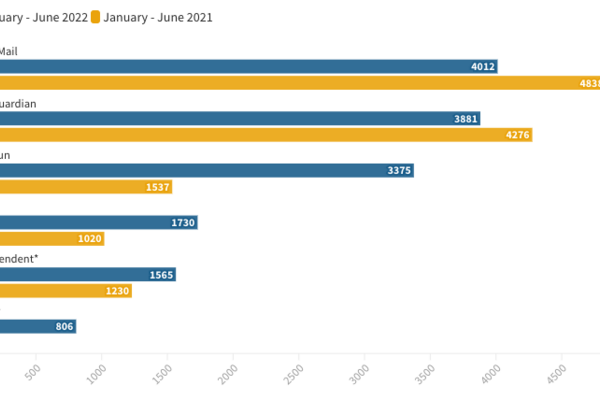Six of the UK’s most popular news outlets have, between them, published over 15,000 articles classed as science, including health, environment, and technology, in the first six months of 2022. Analysis by the ABSW found that these articles, on the websites of BBC News, Daily Mail, The Guardian, The Independent, The Mirror, and The Sun, were written or contributed to by over 2,200 different authors. These articles covered everything from the first images from the James Webb Space Telescope to the monkeypox outbreak.
The new data continues the ongoing project by the ABSW to explore the prevalence of science in the UK mainstream media, and to learn more about the people writing about science. The work follows on from previous studies by Cardiff University in 2009, and by ABSW project student Ben Nealon over 2019 and 2020. The project seeks to monitor whether the number of science writers is increasing or decreasing over time. It also aims to give ABSW members in the UK mainstream media and beyond an understanding of the different news outlets’ hiring practices and outputs. It enables the ABSW to reach out to those who are writing about science regularly and are not yet members, and to provide helpful and relevant support and content.
This chart shows the numbers of articles per news outlet for the six month period, compared to the same time period in 2021. The Daily Mail and The Guardian continue to have the largest numbers of science articles over the time period, although the numbers appear to be lower compared to last year. The number of articles for The Sun and the Daily Mirror appear to have increased compared to last year. The news outlets indicated with a * cannot be compared, due to some missing data in 2021.
Andy Extance, ABSW chair and freelance science writer, used commercial apps to scrape data from the websites of BBC News, Daily Mail, The Guardian, Independent, Mirror, and The Sun, over the period. This data included article titles, author names, and time of publication for all stories classed as science, technology, health or environment by the news outlets. Rebecca Landon, data analyst and MSc Science Communication student, cleaned and analysed the data.
Over 50% of the science articles were written or contributed to by just 40 individuals. The most prolific writer, Jamie Harris at The Sun, contributed to over 500 science articles over the period. Harris was one of six new names in the 20 most prolific writers. All writers in the top 20 have job titles which suggest they specialise in science or technology writing, according to their LinkedIn pages.
The data reveals possible differences in hiring practices of the news outlets and tells us how the numbers of science writers in UK mainstream media are changing over time.

There are some limitations to the data. The news outlets themselves decide which articles to categorise as ‘science’, and some may be more liberal with this definition than others.
Secondly, it appears that some news outlets, including BBC News, may only include a sample of the articles in their RSS feeds, meaning the figures for these news outlets and the individuals that write for them may actually be much higher.
We excluded several outlets from this analysis. We excluded the Daily Express, the Daily Telegraph, The i, and The Times on this occasion as there were periods when the data streams appeared to stop working. Therefore, we can’t be certain that this didn’t happen in a less noticeable way for other publications. We also excluded ITV, and Channel 4, because their websites don’t publish text news stories with author names. We excluded Sky because the content of its feed had too great a non-science content, although we believe we have found a way around this for future analyses. Finally, we excluded the Financial Times because we couldn’t get the scraping apps to extract author names, likely due to how its paywall works.
Resource for ABSW members
Members can view an interactive diagram showing the number of articles contributed to by each of the different writers. The bigger the slice, the more articles contributed to. The Daily Mail and The Guardian had the largest numbers of science articles over the period. The diagram shows how the Daily Mail appeared to favour using regular contributors. By contrast, The Guardian appears to prefer using many freelance writers in addition to a smaller number of regular contributors.










